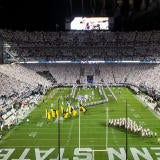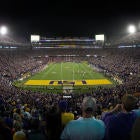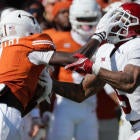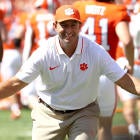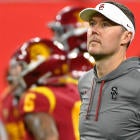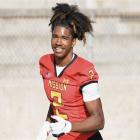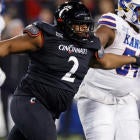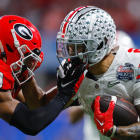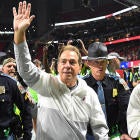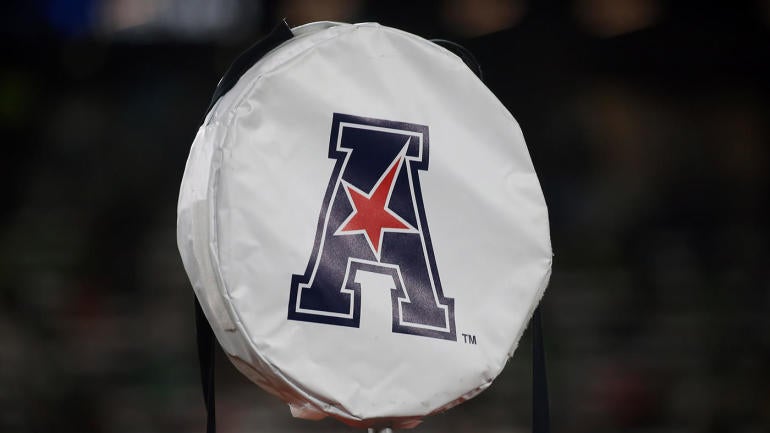
IRVING, Texas -- Officials around the American Athletic Conference expressed frustration with the resolution of the House v. NCAA settlement and how it will affect the league heading forward.
"Frustration and disappointment are probably the couple of words you hear from a lot of us outside of the Power Four," North Texas athletic director Jared Mosley told CBS Sports on Thursday. "Just because a lot of this was kind of sprung on us ... the fact we're going to now have to take a significant chunk of this [back pay] to what we've been told is going to be 90% Power Five football and basketball players, it's just hard to reconcile how we're taking current opportunities and services away from our students for a problem we didn't necessarily create."
The settlement, which is still pending approval from a judge, is slated to pay $2.8 billion over the next 10 years in back damages to former college athletes from 2016-21. The NCAA office will take on a portion of the settlement. Out of the remaining amount, 40% will be paid by the legacy Power Five, with 60% coming from the Group of Five, FCS and non-football Division I leagues.
If the NCAA did not settle, damages instituted by a judge could have been enough to bankrupt the organization.
"We thought [the settlement] was necessary, we understand the threat of bankruptcy," AAC commissioner Mike Aresco said. "But what we didn't appreciate is we really didn't get involved in discussions early on, and yet we were responsible for a part of it."
The five power conferences were all named parties to the House v. NCAA lawsuit, along with the NCAA. Because of that, each of them -- as they existed when the lawsuit was filed in 2021 -- needed to approve the settlement. Approval from Group of Five conferences like the AAC was rolled into the NCAA Board of Governors agreement.
Aresco noted that some adjustments to how settlement payments would get calculated could ease the burden on the AAC. A memo obtained by Yahoo Sports set the AAC's potential cost at more than $8 million per year, or more than $500,000 per member, over the next 10 years. This as the Group of Five is also set to receive a smaller piece of the new ESPN contract signed with the College Football Playoff, despite far more revenue overall.
"To go backwards at a time that the contract more than doubled is kind of absurd," Tulsa athletic director Rick Dickson said. "So you have that double impact of ... a reduction in the growth of revenues, and we're given a disproportionate share of the bill."
An alternate proposal was put forth by the CCA 22 – the 22 non-FBS conferences in Division I – that would have forced the Power Five to pay 60% instead of 40%. However, it was ultimately passed over. The proposal would not have impacted the AAC's portion significantly.
Ultimately, only 40% of the NCAA's payout reduction will be felt by Power Five schools. Group of Five schools will pay 17%, with the rest coming from FCS, non-football schools and other sources. The payments are calculated based on distributions from the NCAA to member institutions over the years.
"It squarely puts the light on the group that's driving the bus at the [Autonomy 4] level, and really, you could probably refer to them as the A2," said Dickson, who will retire on June 30. "As a guy that's going out the door in 30 days, that's a lot of the root of what the majority of us are dealing with in conferences like this. It's all being tilted overwhelmingly towards two entities in a way that's hard to argue is a benefit for all."
Perhaps the largest dynamic shift comes from revenue-sharing. FBS teams will have a cap of approximately $22 million in direct payment to athletes, though details are still getting worked out. It's unclear whether this will impact Group of Five conferences, but multiple ADs said there's essentially no way to take on $20 million a year realistically. And perhaps most vexing, there's no firm end to antitrust cases against the NCAA, so it's unclear how much the settlement will solve.
"We don't know what we bought," Aresco said. "What kind of antitrust protection do you have when there's a cap? Is Congress going to help us? I don't know that they necessarily will. The other issue is that we didn't collectively bargain with anyone, so if someone attacks the cap, can we defend? I hope we can."
Multiple athletic directors acknowledged that cutting sports or other extreme action remains a possibility based on how the settlement is administered. Still, there's little interest from those in the room to break off or move away from the power leagues in any meaningful way.
"I do think the one thing that we have to do is draw a line in the sand and continue to fight for access," Mosley said. "Having opportunities in the CFP, having opportunities for our teams to compete in March Madness and other championships. As long as we have that, we can figure out within our world that we live in how to best do that and put people in the best possible position to have success."

